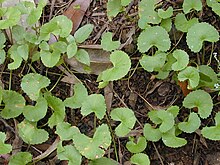
Centella asiatica, commonly known as centella and gotu kola, is a small, herbaceous, frost-tender perennial plant of the family Mackinlayaceae or subfamily Mackinlayoideae of family Apiaceae, and is native to wetlands in Asia. It is used as a medicinal herb in Ayurvedic medicine, traditional African medicine, and traditional Chinese medicine. It is also known as the Asiatic pennywort or Indian pennywort in English, among various other names in other languages.
Centella grows in tropical swampy areas. The stems are slender, creeping stolons, green to reddish-green in color, connecting plants to each other. It has long-stalked, green, rounded apices which have smooth texture with palmately netted veins. The leaves are borne on pericladial petioles, around 2 cm. The rootstock consists of rhizomes, growing vertically down. They are creamish in color and covered with root hairs.
The flowers are white or pinkish to red in color, born in small, rounded bunches (umbels) near the surface of the soil. Each flower is partly enclosed in two green bracts. The hermaphrodite flowers are minute in size (less than 3 mm), with 5-6 corolla lobes per flower. Each flower bears five stamens and two styles. The fruit are densely reticulate, distinguishing it from species of Hydrocotyle which have smooth, ribbed or warty fruit. The crop matures in three months, and the whole plant, including the roots, is harvested manually.
Centella asiatica is indigenous to the Indian subcontinent, Southeast Asia, and wetland regions of the Southeastern US. Because the plant is aquatic, it is especially sensitive to biological and chemical pollutants in the water, which may be absorbed into the plant.
Centella is used as a leafy green in Sri Lankan cuisine, where it is called gotu kola. In Sinhalese, gotu is translated as "conical shape" and kola as "leaf". It is most often prepared as malluma (මැල්ලුම), a traditional accompaniment to rice and curry, and goes especially well with vegetarian dishes, such as dhal, and jackfruit or pumpkin curry. It is considered quite nutritious. In addition to finely chopped gotu kola, malluma almost always contains grated coconut, and may also contain finely chopped green chilis, chili powder, turmeric powder and lime (or lemon) juice. A variation of the nutritious porridge known as kola kenda is also made with gotu kola by the Sinhalese people of Sri Lanka. Kola Kenda is made with very well-boiled red rice (with extra liquid), coconut milk and gotu kola, which is pureed. The porridge is accompanied with jaggery for sweetness. Centella leaves are also used in sweet "pennywort" drinks.
In Indonesia, the leaves are used for sambai oi peuga-ga, an Aceh type of salad, and is also mixed into asinan in Bogor.
In Vietnam and Thailand, this leaf is used for preparing a drink or can be eaten in raw form in salads or cold rolls. In Bangkok, vendors in the famous Chatuchak Weekend Market sell it alongside coconut, roselle, chrysanthemum, orange and other health drinks.
In Malay cuisine the leaves of this plant are used for ulam, a type of Malay salad.
It is one of the constituents of the Indian summer drink thandaayyee.
In Bangladeshi cuisine mashed centella is eaten with rice.
Centella is widely used in various Indian Regional cuisines. It is known as vallarai in Tamil. It is an important component of unave marunthu concept which translates to food is medicine. Vallarai Kootu is a dish made out of centella and Dal. Vallarai thuvaiyal/thugaiyal, poriyal, spice podi (to be mixed with rice and ghee) and chutney are all various applications of centella in home cooking.
According to the American Cancer Society, although C. asiatica is promoted for its health benefits, "available scientific evidence does not support claims of its effectiveness for treating cancer or any other disease in humans".
In South Asia, other common names of centella include ଥାଲକୂଡ଼ି (Thalkudi) in Odia సరస్వతి ఆకు (sarswathi aku) in Telugu; കുടവൻ (kudavan), മുത്തിൾ (muththil), or കുടങ്ങൽ (kudangal) in Malayalam; থানকুনি (thankuni) in Bengali; ගොටුකොල (gotu kola) in Sinhala; ब्राम्ही / ब्राह्मी (brahmi) in Marathi: ಒಂದೆಲಗ (ondelaga) in Kannada; வல்லாரை (vallaarai) in Tamil; ျမင္းခြာ (myin-khwar) in Burmese; brahmi booti in Hindi; perook in Manipuri; মানিমুনি (manimuni) in Assamese; timare in Tulu; tangkuanteh in Paite; ब्रह्मबुटि (brahmabuti) or घोडताप्रे (ghod-tapre) in Nepali; and खोलचा घायँ (kholcha ghyan) in Newari (Nepal Bhasa).
In India, particularly, it is popularly known by a variety of names: bemgsag, brahma manduki, brahmanduki, brahmi, ondelaga or ekpanni (south India, west India), sarswathi aku (Andhra Pradesh), gotu kola, khulakhudi, mandukparni, mandookaparni, or thankuni (Bengal), depending on region. Bacopa monnieri is the more widely known Brahmi; both have some common therapeutic properties in Vedic texts and are used for improving memory. C. asiatica is called brahmi particularly in north India, although that may be a case of mistaken identity introduced during the 16th century, when brahmi was confused with mandukaparni, a name for C. asiatica. Probably the earliest study of mandookaparni as medya rasayana (improving the mental ability) was carried out at the Dr. A. Lakshmipathy Research Centre (now under CCRAS).
In Southeast Asia, it is known as ស្លឹកត្រចៀកក្រាញ់ (sleuk tracheakkranh) in Khmer;(mying khwar which means "Horse Hoof leaf" ) in Burmese; บัวบก (bua bok; "land lily") in Thai; rau má ("mother vegetable") in Vietnamese; pegagan or antanan in Indonesian; takip-kohol (literally "snail lid")or yahong yahong ("little bowl") in Filipino; and pegagan or pegaga in Malay.
In East Asia, it is known as 雷公根 (lei gong gen; literally "thunder god's root") or 崩大碗 (bang dai wun; literally "chipped big bowl") in Chinese; and 병풀 (byeong-pul, 甁—, literally "bottle/jar grass") in Korean.
No comments:
Post a Comment